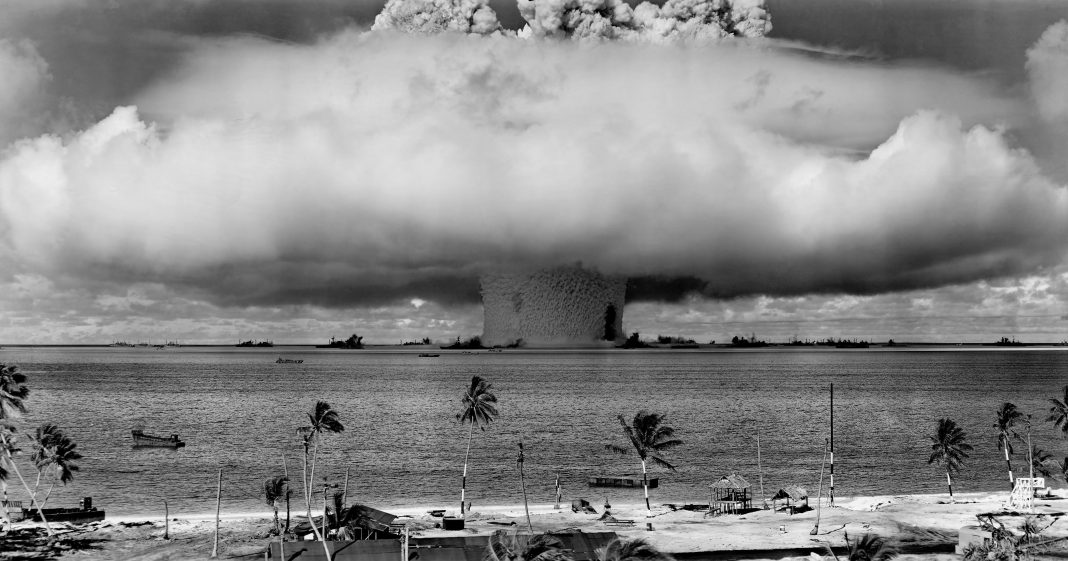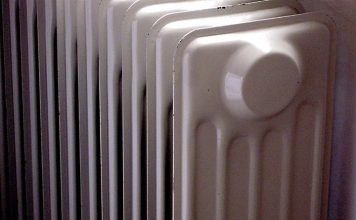By John Silveira |
 |
| Issue #114 • November/December, 2008 |
[Part I: Our energy crisis: It’s our creation, but we can fix it]
When an atomic bomb was detonated over Nagasaki, Japan, August 9, 1945, the amount of energy released by the explosion amounted to roughly 21,000 tons of TNT. The blast destroyed much of the city and killed as many as 80,000 thousand people.
That bomb and the one dropped three days earlier on Hiroshima were the two most fearsome weapons ever used in warfare. They introduced the world to what some commentators deemed the “nuclear age,” an age filled with both terror and promise. While some feared this new weapon would destroy civilizationand even send the human species into extinctionothers looked at what fueled that explosion and saw promise.
|
The Nagasaki bomb, nicknamed “Fat Man” because of its shape, contained some 13½ pounds of plutonium, shaped in a sphere about the size of a softball, of which only about 2¼ pounds underwent fission. The rest was simply blown away before it could come into play.
So, how does plutonium cause an explosion?
When many of the heavy, unstable elements undergo fission, i.e., when their atomic nuclei are split, the results are new, lighter atomic nuclei, some neutrons, and the release of a huge amount of energy. The source of that energy is the conversion of part of the mass of the original atom into pure energyeither radiation or kinetic energy. (To see how an atomic bomb works see my article, Nuclear Terrorism, in BHM’s Issue 74, March/April 2002, also contained in BHM’s 13th Year Anthology. The article is also on the BHM website.)
But, of that 2¼ pounds that underwent fission, how much of it was actually converted into energy? Only about one gram. That’s approximately .035 ounces of the plutonium nucleior the weight of a one dollar billthat, when converted to energy, created that terrible explosion.
Search for an alternative
And it is exactly this that makes the conversion of matter into energy, either by fission or, as you’ll see, by fusion, such an attractive alternative as we search for a better way to fuel our civilization.
Energy is the basic commodity on which modern civilization runs. Whether it’s cars and trucks, planes, factories, or TV and cell phones, without economical and easily obtainable energy, civilization will grind to a halt. It is the lifeblood of our modern world.
When World War II ended, many of the world’s scientific and technical minds turned to the energy locked up in the atomic nucleus as a source of power for something other than a destructive explosion.
The military looked at the applications of atomic power to power ships. Under the direction of Admiral Hyman Rickover, the U.S. Navy soon produced the nuclear-powered submarine Nautilus, and since then have produced more than 200 nuclear submarines, 23 nuclear aircraft carriers, and a variety of nuclear missile cruisers.
|
But there was also the hope that we could electrify the nation, and perhaps the world, with the power locked up in the atom.
Today it may be more than just a hope, it may be an imperative. With the skyrocketing price of petroleum, the United States is witnessing the biggest transfer of wealth from one set of countries to another in history. The damage it is doing to the American economy is inestimable.
Unlike countries such as Japan that created its wealth by building one of the mightiest technological and industrial bases in history and selling their products at fair-market prices, the OPEC countries are accumulating their prodigious wealth merely because they are sitting on top of some of the greatest accretions of natural resources ever discovered. (Never mind that the U.S. is also sitting on another massive deposit of useable fossil fuel, namely coal, but we have failed to exploit it properly. See Backwoods Home Magazine Issue 113, Sept./Oct 2008.)
Practical energy solutions, such as the pursuit of viable nuclear power, are going to be needed to extricate the United States from the grip of OPEC and its expensive energy.
Nuclear fission
Six years after Hiroshima and Nagasaki, the first nuclear reactor built to generate electricity was the Arco reactor built near Arco, Idaho, in 1951. But the first one to generate electricity to be fed into an electric power grid was the Obninsk Nuclear Power Plant, built in 1954, in the former Soviet Union.
Following that, in 1956 the first commercial reactor, Calder Hall, came on line in Sellafield, England. A year later, the first commercial reactor to come on line in the United States was the Shippingport Reactor in Pennsylvania, about 25 miles from Pittsburgh. The Shippingport reactor was another Rickover project he developed at the request of the Atomic Energy Commission.It looked like we were on our way to developing into a nuclear power-fueled nation.
It’s fair to say that, almost from the beginning, nuclear fission, as a source of energy, was essentially solved. Today there are at least 439 nuclear power plants around the world, located in 31 countries, including 104 operational commercial nuclear power plants in the United States.
About 6½% of the world’s power, including some 15% of the world’s electricity, now comes from nuclear power with the U.S., France, and Japan accounting for more than half of it.
In 1960, the Atomic Energy Commission estimated there would be as many as 1,000 nuclear power plants in the United States by the year 2000. But that never happened.
Nuclear falls out of favor
In the 1970s and through the 1980s, events occurred that caused nuclear power to fall into disfavor in the United States. Not only did the growth slow, but more than 120 orders for commercial reactors were cancelled. The last reactor to come on line in the United States was the the Watts Bar 1 reactor in Tennessee, which became operational in 1996.
The two crucial events that began to turn the American public against nuclear power were the partial meltdown of one of the reactors at Three Mile Island in Pennsylvania, in 1979, and the meltdown and reactor fire at Chernobyl, in Ukraine, in 1986.
|
The first, Three Mile Island, was a “contained” accident whereas the accident at Chernobyl resulted in a fire and a meltdown which soon killed at least 56 people, affected several million others, may have caused as many as 9,000 extra cancers, and temporarily contaminated, to a greater or lesser degree, an area spread over tens of thousands of square miles. Today, in Ukraine, there is a 19-mile radius zone, sometimes referred to as the Zone of Alienation, surrounding the site of the reactor, from which most people are excluded.
However, according to the World Nuclear Association, as of June 2008 Three Mile Island and Chernobyl are still the only two major accidents in 12,700 cumulative reactor-years for commercial reactors in 32 countries.
To the press Three Mile Island and Chernobyl were black eyes for nuclear power. The two events, along with scare tactics used by environmental groups, brought a nuclear dark age to the United States. But, in reality, Three Mile Island was an unparalleled success story the safety features worked as intended. That is the reason the damage was minimized.
On the other hand, the problems at Chernobyl were that the reactors there were built with no provision for containment and they were built without “passive safety” features. (See sidebar on Nuclear accidents and passively safe reactors.) Reactors in the West, and particularly in this country, have always been built with containment as a priority, and now passive safety is a priority.
China has ordered 100 nuclear power plants
Though nuclear power is almost in a deep freeze in the United States, the 104 nuclear power plants currently operating account for almost 20 percent of our electricity. But in the European Union, about 30% of the electricity comes from nuclear sources. In France, nearly 80% of their electricity comes from nuclear power plants.
Today France, Germany, and Japan, three countries poor in other energy resources, are quietly building more reactors. Meanwhile, the People’s Republic of China, which has 11 nuclear power reactors, has recently ordered 100 more nuclear power plants from Westinghouse. Theirs is one of the most ambitious nuclear programs on the planet. They intend, by 2030, to have roughly 2½ times the nuclear power capacity of the United States. It has been pointed out by proponents of nuclear energy that one of the reasons China is able to embark on a program to bring nuclear energy to their country is that many of the upper-echelon members of the Chinese political elite are engineers by training, not lawyers.
In the meantime, while the development of nuclear power goes on in the rest of the world, the United States has not brought a nuclear power plant on line in more than a dozen years.
Nuclear advantages
|
There are obvious advantages to going nuclear, including becoming less energy dependent on foreign sources. Notice, I did not say “achieve total energy independence.” That’s not going to happen. It doesn’t even make sense to try to make it happen.
What this nation needs are enough alternative sources of energy to keep the cost of foreign energy down to a fair price. If petroleum is sold at free market prices instead of cartel prices, we can afford it. Petroleum at the wellhead would now cost less than $30 a barreland OPEC would still be making a profitif we’d had a sensible energy policy, including more nuclear power plants, for the last four decades.
Among its uses, nuclear power has natural applications in the production of other fuels. Half the excessive pollutants from Coal-To-Liquid (CTL) fuels are the result of burning other fossil fuels to provide energy for processing the coal. The use of nuclear power to produce these and other fuels will dramatically reduce these pollutants. And the production of alternative motor fuels from coal is one way to drive down the price of imported oil. (See Backwoods Home Magazine, Issue 113, Sept/Oct 2008.)
Nuclear power can also provide the electricity to produce hydrogen from the electrolysis of water, which may become a fuel for powering automobiles and trucks. It is also a way of producing the electricity for electric cars and hybrids.
Another attractive feature of nuclear reactors is that some can be used to create more fuel than they “burn.” These are called breeder reactors. These reactors allow us to make more nuclear fuel from otherwise “unusable” heavy elements. (See sidebar.)
Nuclear power is safe
Because of Three Mile Island and Chernobyl, nuclear safety is one of the first thoughts that comes to mind when nuclear power is mentioned. But one thing the public is largely unaware of is that a Chernobyl disaster cannot occur in the United States, simply because we have no reactors of that design, nor would we ever allow one to be built.
Another thing that cannot happen in a nuclear reactor is a nuclear explosion. Atomic bombs are hard to make and the conditions for one just don’t exist in a reactor.
Safety features for modern nuclear reactors account for about a quarter of the capital costs for the building of the reactor. Reactor safety is always paramount when building a plant and it is estimated that the likelihood of reactor damage, such as leaks or a meltdown, in modern reactors is less than one in 1,000,000 years of reactor operation.
New nuclear power plants are now designed to survive natural catastrophes including earthquakes, tornados, and hurricanes as well as man-made disasters including terrorist threats.
Today’s nuclear reactors are so robust that it is expected they would survive the impact of a fully-fueled Boeing 767-400 slamming into the containment building at over 300 mph. (Why 300 mph? That’s probably the highest speed at which terrorists, even if they are experienced pilots, can control the plane for precise impact with a target the size of the containment building.)
New safety features built into modern reactors, in particular the construction of what are called “passively safe” reactors, are going to make new reactors even safer. A passively safe reactor is one that is designed to shut itself down when the reactor begins to malfunction. (See sidebar.)
According to PBS Online, no deaths have been attributed to U.S. nuclear power in its entire history. On the other hand, factoring in deaths from mining, transportation accidents, respiratory complications, and other factors, more than 30,000 deaths have been attributed to coal since 1930.
|
Nuclear waste problem political, not technical
The other bogeyman in nuclear power is nuclear waste. It’s a problem. But it’s a political problem, not a technological one. There are viable solutions today for its disposable, and future solutions just get better.
First, it’s worth noting that the first commercial nuclear plant, the Shippingport plant mentioned earlier, was decommissioned in 1982. The reactor was removed for burial in Washington State, and the Pennsylvania site where it once stood was cleaned up and released for unrestricted use. Cleanup is not just possible, but it’s been done.
Second, we already have the technology to make more efficient reactors that will burn their own waste, creating even more energy. This is particularly true for breeder reactors that use thorium-232 in their breeder blankets. The extra neutrons that are produced will convert the thorium to uranium 233, another fissile isotope of uranium that can be used to fuel the reactor, thereby decreasing the amount of waste the reactor produces.
Third, there are various strategies for disposing of reactor waste. Among some that already work well is embedding the waste in molten glass, pouring it into stainless steel containers, sealing them, then storing the containers away. The waste can be stored this way for thousands of years or until future technologies can dispose of them in other fashions.
Promising future strategies are to irradiate the radioactive components in reactors to form other isotopes which are either stable or have extremely short half-lives so they decay to stable isotopes in a short time. (At the same time, the irradiating plant would be creating electric power. It’s a double bonus.)
But one of the best alternatives, and one we’re likely to see used in the future, is to bury the wastes at subduction zones in deep ocean trenches. Subduction zones are places along the earth’s crust where old rock sinks into the mantle where it is recycled and it will not reappear for millions of years. In that time, their radioactivity will have been both diluted and reduced.
Fusion power
Nuclear fusion is another source of atomic energy scientists are pursuing. Fusion is what powers many stars including our sun. Scientists now hope it will be the solution to civilization’s quest for a practical source of affordable energy.
We have already released fusion power with the hydrogen bomb, the most powerful weapon mankind can now manufacture. We have even created fusion in the laboratory and, if we can ever perfect it so it’s economical and sustainable, we will have virtually unlimited energy with which to power our world.
|
But therein is the rub: Can we ever get fusion out of the lab and into the economy? It is the power locked up in as little as one gram of mass that makes the reward for achieving it so attractive. But there are scientists who think man-made fusion power will never be any more than a laboratory curiosity. And they may have good reason to think so.
While fission is the splitting of the nuclei of very heavy elements to release energy, fusion involves the fusing of the nuclei of very light elements to release energy.
It was very easy to make fusion weapons, which were immediately more efficient than the fission weapons they’ve now largely replaced. The very first hydrogen bombs released about 500 times the energy of the first atomic bombs. But using fusion to produce energy for the generation of electricity has proved to be much more difficult than the the fission-based nuclear reactors that are now in place all over the world.
In the simplest fusion picture, we see the nuclei of atoms of hydrogen somehow combining to form helium. Things are not that simple. The most promising way to fuse atomic nuclei to form helium, thus releasing vast amounts of energy, is to use two different isotopes of hydrogen, namely, deuterium (which is a hydrogen atom whose nucleus is made up of one proton and one neutron) and tritium (which is a hydrogen atom whose nucleus is made up of one proton and two neutrons).
The difficulties with fusing atoms is that they must be brought close enough together to allow their nuclei to fuse. However, the like positive charges of their nuclei means the nuclei are going to repel each other when they get close together. Herein is the problem scientists have had; power must be supplied to overcome these repulsive forces, because only after that’s accomplished is it possible for fusion to take place. But the usable power that results from the fusion must be greater than the power required to create and sustain the fusion or it’s of no use to us. And no one has done that yet.
Fusion naturally takes place in the sun because the sun’s gravitational field holds the hot plasma in place, allowing it to occur. Here on earth we must use other strategies and the best one we’ve come up with relies on the fact that the hot plasma can be influenced by a magnetic field. The Russians surprised scientists in the West when they created the Tokamak reactor, a torus (donut shape) that confines the hot plasma, using powerful magnets, allowing the deuterium and tritium to remain in close enough proximity for fusion to happen and, at the same time, keep the plasma away from the chamber’s walls. The name Tokamak is a Russian acronym standing for “toroidal chamber with magnetic coils.” The Tokamak design is now the standard by which most scientists are trying to make a practical fusion reactor.
In the meantime, there are other strategies by which scientists are trying to create fusion. One involves compressing pellets containing deuterium and tritium with powerful lasers. A test reactor that will be as large as a football stadium when it’s completed, is now under construction at the Lawrence Livermore National Laboratory, located in the San Francisco Bay Area. The hope is that by using 192 lasers, focused on the fuel pellets, they can heat and implode them to fuse the deuterium-tritium mixture inside.
These and other strategies tried so far almost all create fusion, but none so far has produced more energy than it consumes.
Back in 1970 it was predicted we’d have the first commercial fusion reactors on line and producing electricity by the year 2000. But 2000 came and went with no fusion reactors on line. Today, the forecast is grimmer. Researchers are hoping maybe we’ll have one by 2050. In the meantime, there are others who think we may be a century or more away. But, as I said, there are yet others who believe we may never see a commercial fusion reactor at all.
So the race goes on because, compared to any other sources of energy, the advantages of fusion power are:
- The fuel would be virtually limitless.
- It’s essentially clean because it will emit little or no pollutants including the so-called greenhouse gases.
- A meltdown isn’t possible because the second the plasma is compromised, the reaction instantly stops. So, in its “worst-case scenario” a fusion reactor is not only safer than a fission reactor, but it is safer than any conventional fossil fuel power station.
There is a small problem of one of the radioactive isotopes of hydrogentritiumgetting released into the environment. But the half-life of tritium is relatively short and the dilution factor is so great that by the time it reached the fences where the reactor is housed it would be diluted to acceptable quantities.
|
The future of nuclear
The Nuclear Power 2010 Program, initiated in 2002, was initiated to examine the needs and prospects for resuming the construction of nuclear power plants in the United States. Because of that and other programs, today, after a long moratorium, there are now more than 20 new nuclear plants planned in the United States. Construction on Watts Bar 2 reactor, in Tennessee, which was suspended in 1995 when it was 80 percent completed, was resumed in late 2007. It is scheduled to be completed in 2013. None of the other 20 or so will come on line until 2013 to 2015. They’re late in coming, but the use of nuclear power will make us less dependent on fossil fuels and, despite the cries of the naysayers, they’ll make a cleaner world for us and our children.
Energy shortages, rising fuel prices, and pollution concerns including heavy metals and the so-called greenhouse gases that are by-products of the burning of fossil fuels are going to force us take a hard new look at the nuclear power that is possible today.
Next issue I’ll conclude this three-part series by examining the alternative energies such as wind, solar, hydro, etc. They are the energies the individual person can adopt in his or her personal lifestyle to relieve the energy crisis on a local level. Many readers of BHM are already using these energy alternatives.
Read Part III: Alternative energy resources for the nation and for the self-reliant
|
|
|
|
|




















